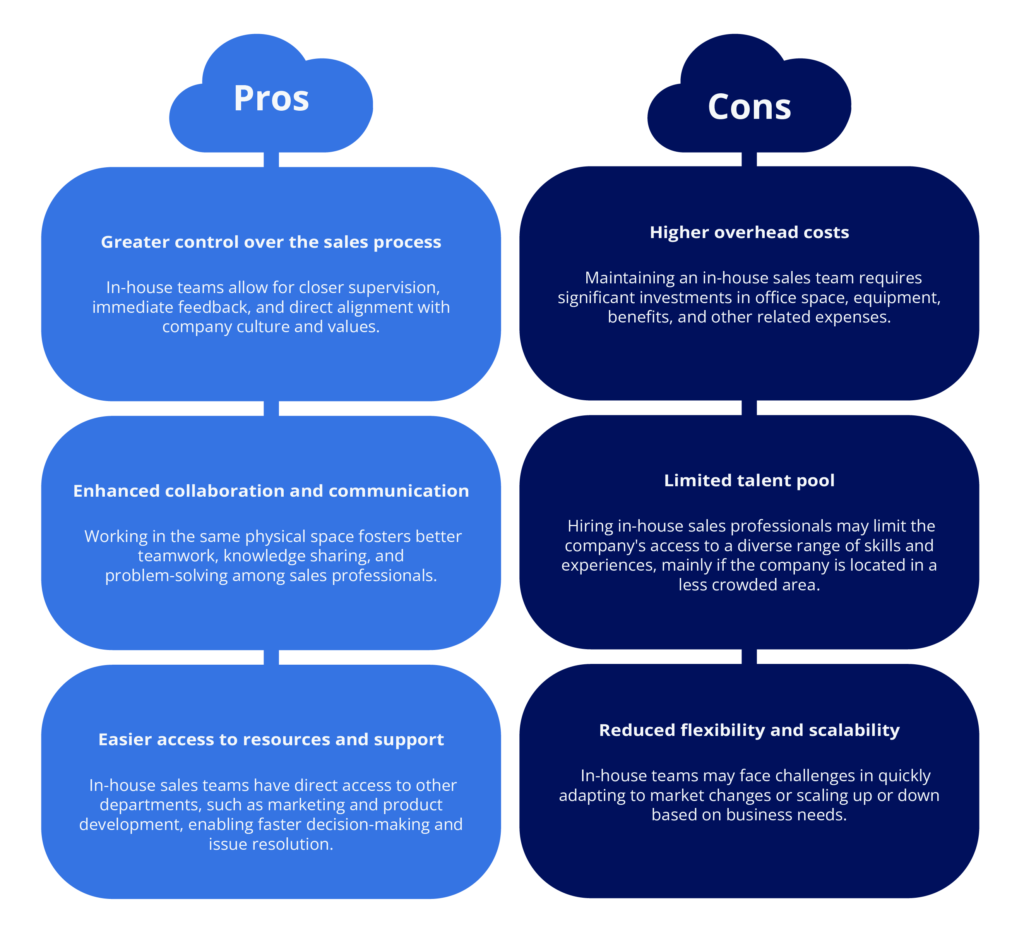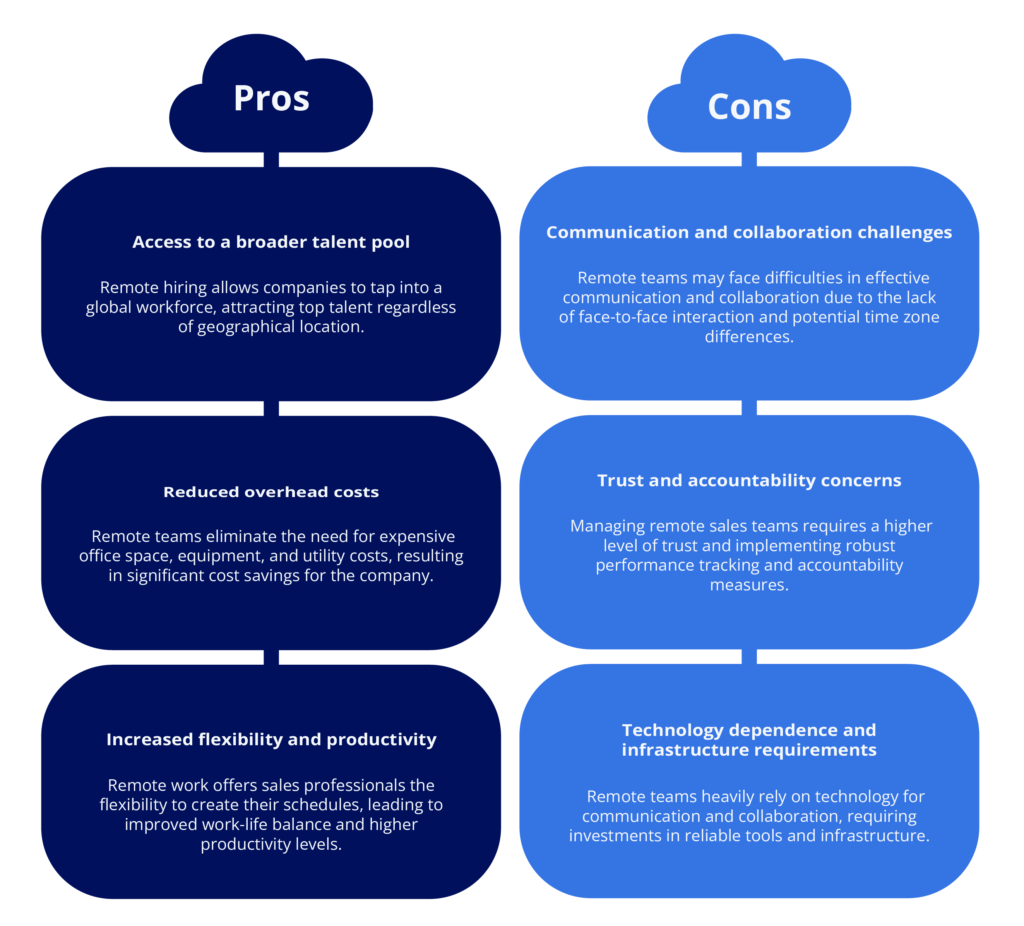Businesses always look for ways to optimize their sales operations while managing costs efficiently, particularly in this highly competitive business environment.
One of the most critical decisions that sales leaders face is whether to build an in-house sales team or take advantage of the benefits offered by remote sales professionals.
The choice between these two options could significantly impact a company’s bottom line, sales performance, and overall growth potential.
However, many businesses struggle with this decision due to a lack of clear understanding of the costs and benefits associated with each approach.
In this blog post, we aim to provide a comprehensive cost breakdown of hiring in-house versus remote sales teams, giving you the necessary insights to make an informed decision for your organization.
In-Depth Look at In-House Sales Teams
Defining in-house sales teams is crucial to understanding their role in an organization.
These teams consist of employees working directly for the company, usually in a centralized office.
In-house sales professionals are hired as full-time staff members and are exclusively dedicated to selling the company’s products or services.
While hiring in-house sales teams offers several advantages, it also comes with challenges.
Let’s take a look at some of the pros and cons of hiring in-house teams:

When considering an in-house sales team, it’s essential to factor in various costs, such as salaries, training, and overheads.
According to a Society for Human Resource Management study, a sales representative’s average cost per hire is $4,425, with an annual average wage of $60,000.
Additionally, companies must account for expenses related to benefits packages, training and development, and overhead costs like office space and equipment.
Analyzing Remote Sales Teams
Remote sales teams are composed of individuals who work from various locations, such as their home office or co-working spaces. These team members may be full-time employees, part-time staff, or independent contractors.
Remote sales teams provide several benefits, but managing a remote team poses challenges.
Some pros and cons of remote sales teams include:

When evaluating the costs of a remote sales team, it’s essential to consider the potential savings in salaries and operational expenses.
According to a study by Global Workplace Analytics, companies can save an average of $11,000 per year per employee who works remotely half the time. These savings stem from reduced office space requirements, lower utility costs, and decreased turnover rates.
Direct Cost Comparison: In-House vs. Remote
In order to comprehend the financial impact of hiring an in-house sales team versus a remote one, it is essential to conduct a comparative analysis.
This analysis should take into account various factors, including salaries, benefits, overhead costs, and potential savings associated with each option.
Here are some key cost differences and data points that should be considered.
In-House Sales Team Expenses:
- Recruitment cost per employee: $30,000.
- Annual payroll, commissions, and benefits per employee: $200,710.
- Training expenses per employee: $3,000.
- Operating expenses per employee: $4,000-$6,000.
- Total costs estimate for a team of 3: $288,000.
Remote Sales Team Advantages:
- Cost Savings:
- Companies that hire remote SDRs in Latin American countries like Colombia and Mexico can achieve 35% lower salary costs than hiring in the US.
- Remote teams eliminate or significantly reduce overhead costs, such as office space, equipment, and utilities, resulting in substantial savings for the company.
- Companies that hire remote SDRs in Latin American countries like Colombia and Mexico can achieve 35% lower salary costs than hiring in the US.
- Revenue Growth:
- In a case study, the first five remote SDR hires from Latin America generated 50% more qualified demos per month than their US counterparts, demonstrating the potential for increased productivity and revenue generation with remote teams.
- In a case study, the first five remote SDR hires from Latin America generated 50% more qualified demos per month than their US counterparts, demonstrating the potential for increased productivity and revenue generation with remote teams.
- Rapid Scaling:
The same case study showed that the company doubled its remote SDR team to 10 reps within just two months, thanks to the strong performance of the initial remote hires, highlighting the ability to scale quickly with remote teams.
- Fast Hiring:
Platforms like CloudTask Marketplace, which offer video profiles of candidates, enable companies to screen and interview top candidates within 48 hours of contacting them, significantly reducing the time-to-hire compared to traditional in-house hiring processes.
- Culture Add:
Remote team members from Latin America often bring an energetic and collaborative culture to the organization, with the added benefit of language skills that can help expand the company’s reach into new markets.
Deciding Between Hiring In-House or Hiring Remote
When deciding whether to have a sales team in-house or remote, it’s important to consider key factors to help determine what’s best for your organization.
These include:
- Company size and growth plans: Smaller companies may benefit from remote teams’ cost savings and flexibility. At the same time, larger organizations with more complex sales processes may prefer the control and collaboration of in-house teams.
- Industry and target market: Some industries, such as technology and software, maybe more adaptable to remote sales, while others, like healthcare or financial services, may require more face-to-face interaction.
- Sales process complexity: An in-house team may be more suitable if your sales process involves intricate product demonstrations or extensive customization. Remote teams may easily manage simpler, more transactional sales processes.
- Organizational culture: Consider whether your company culture values in-person collaboration and team-building or embraces flexibility and autonomy. This can help determine which team structure aligns best with your organization’s values and goals.
- Budget constraints: Evaluate your company’s financial resources and determine whether the cost savings of a remote team outweigh the potential benefits of an in-house team or vice versa.
Ultimately, the decision of hiring in-house or a remote sales team should be tailored to your specific business needs.
Assessing your organization’s readiness to support and manage a remote team effectively is essential, considering factors such as technology infrastructure, communication tools, and performance management processes.
Final Thoughts
Hiring an in-house or remote sales team cannot taken lightly.
While in-house teams offer greater control and collaboration, remote teams provide access to a broader talent pool, increased flexibility, and significant cost savings.
Ultimately, the right choice depends on various factors, including company size, industry, sales process complexity, and organizational culture.
As you consider your options, it’s important to keep in mind that building a successful sales team, whether in-house or remote, requires careful planning, effective management, and a commitment to continuous improvement.
If you’re leaning towards building a remote sales team, CloudTask Marketplace offers a unique opportunity to access top sales talent from Latin America at highly competitive rates.
With over 500 skilled sales professionals, you can quickly and easily find the right fit for your remote sales teams, while also benefiting from cost savings of up to 40% compared to hiring locally.








